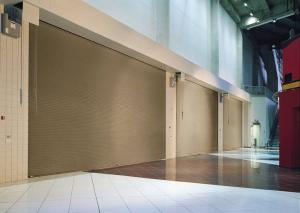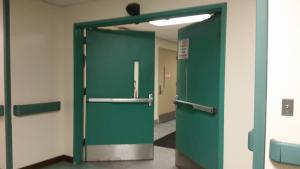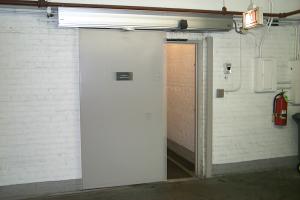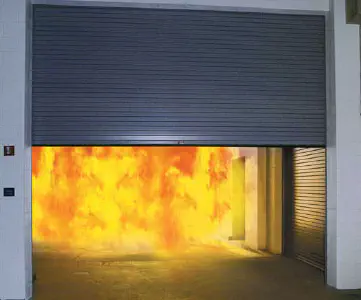Fire Door Testing - Required by Building Code
Is your building fire protection system up to code? Do you regularly check the functionality of your fire-doors? Will they work in the event of a fire?
Fire Door Testing: What is it? Why Bother?
- Test and inspection of the door’s performance in the event of a fire, and the doors components’ compliance with fire codes.
- Documentation for insurance and inspection purposes
Building Codes for Fire Barriers and Fire Doors
NFPA 80 Fire Code 15-2.4.3
All horizontal or vertical sliding and rolling fire doors shall be inspected and tested annually to check for proper operation and full closure.
Resetting of the release mechanism shall be done in accordance with the manufacturer’s instructions.
Fire door hardware must be rated and labeled to maintain the fire door’s rating
A written record shall be maintained and be made available to the authority having jurisdiction.
OSHA Fire Wall Definitions and Requirements:
Every large building needs to be divided into fire compartments to limit the spread of fire and restrict the movement of smoke. (NFPA 101 Section 8.2.2.1)
Fire compartments are formed by fire barriers that are continuous from outside wall to outside wall or from one fire barrier to another, or a combination thereof, including continuity through all concealed spaces, such as those found above a ceiling, including interstitial spaces. (NFPA 101 Section 8.2.2.2)
How effective are they? Is testing a waste of time and money?
The U.S. Fire Administration states that annually:
- “86,500 nonresidential building fires were reported to United States fire departments each year and caused an estimated 85 deaths, 1,325 injuries, and$2.6 billion in property losses per year.”
- “56 %of nonresidential building fires extended beyond the room of origin. The leading causes of these larger fires were unintentional or careless actions”
What is Fire Door Testing? What does Fire Door Testing entail?
- Inspection of Door Components for functionality, connectedness and compliance with NFPA 80 Requirements
- Drop testing and release of the doors, ensuring they meet the NFPA 80 requirement
Fire Door Testing Checks
Door Condition
- Curtain
- Slat End locks and Guide Track
- Hood Condition
- Kinked Cables
- Bottom bar condition
- Door labels not painted
Door area and mounting
- Wall condition
- Objects in the way
- Gaps in closed door and floor
Door Operation
- Drop Door and Test closing speed
- Fuse link or auto-test operation.
- Fuse Link not Painted over, dust and grease free
- Reset door and link
What are Fire Doors?
Fire Doors protect the opening in the fire wall, they are rated to withstand a fire for a certain amount of time, form 20 minutes to 3 hrs. They can be rolling doors, counter fire doors, pedestrian fire doors, or sliding fire doors.
Rolling Fire Doors
 Rolling Doors roll up above the opening into a barrel. They are composed of interlocking slats and feature either a fusible link and cable or other release device tied to an alarm system that triggers their release in a fire. Counter Fire Doors are similar to full-size rolling doors but are for counter applications where a fire hazard may exist, such as a cafeteria service counter
Rolling Doors roll up above the opening into a barrel. They are composed of interlocking slats and feature either a fusible link and cable or other release device tied to an alarm system that triggers their release in a fire. Counter Fire Doors are similar to full-size rolling doors but are for counter applications where a fire hazard may exist, such as a cafeteria service counter
Swing Fire Doors
 Swing fire doors are the most common fire-door and the least inspected door. They often cause inspection failure and frustrations. Punctures and drill holes, gaps in the seals, non-functioning closers or obstructions in the doorway are common problems.
Swing fire doors are the most common fire-door and the least inspected door. They often cause inspection failure and frustrations. Punctures and drill holes, gaps in the seals, non-functioning closers or obstructions in the doorway are common problems.
Sliding Doors
 Sliding doors slide on a track out of the way of the opening. In the event of a fire a fusible link or electro-mechanical trigger releases the door, and hidden counterbalance weights and cables pull the door shut.
Sliding doors slide on a track out of the way of the opening. In the event of a fire a fusible link or electro-mechanical trigger releases the door, and hidden counterbalance weights and cables pull the door shut.
Fire Doors in the Building Fire Protection System
A building typically has a few critical forms of fire defense - the most readily apparent and understood being the Active Fire Protection systems: Smoke Detectors and Alarms, Sprinklers and Extinguishers.
Fire Doors are part of a buildings Passive Protection system, which includes Fire Rated Walls which compartmentalize the building from common fire causing areas such as kitchens, boiler and electrical rooms, as well as hallways and staircases that can act as a vehicle for the spread of fire.
Look for the Label: Fire Door Testing and Certification
Labeling
Fire doors all have a special Fire Door Label unless it is missing or has been tampered with. Fire door manufacturers undergo rigorous testing of the doors they manufacture along with annual inspections for compliance by certification companies such as Underwriters Laboratories (UL), FM, or Wernock Hersey. Painting over your labels or attempting to modify them can void a fire door certification and a failed inspection from the fire marshall.
Existing doors cannot be re-certified easily, except through re-labeling companies which are prohibitively expensive. Industrial Door cannot re-label fire doors.
Certification
A sample door is subjected to a test of increasing temperatures up to 2000 °F for 4 hrs and then blasted with a high pressure hose to check for gaps, penetrations or deforming. Doors made with the same manufacturing process and size can be labeled as “Fire Doors”
Industrial Door Fire Door Testing
- Identify Minor Problems before they become Costly Nightmares
- Avoid Building Code Violations
- Written Record of Inspection for Insurance and Liability Purposes
Visit our Fire Door Testing and Maintenance page to learn more and schedule your inspection.


 Rolling Doors roll up above the opening into a barrel. They are composed of interlocking slats and feature either a fusible link and cable or other release device tied to an alarm system that triggers their release in a fire. Counter Fire Doors are similar to full-size rolling doors but are for counter applications where a fire hazard may exist, such as a cafeteria service counter
Rolling Doors roll up above the opening into a barrel. They are composed of interlocking slats and feature either a fusible link and cable or other release device tied to an alarm system that triggers their release in a fire. Counter Fire Doors are similar to full-size rolling doors but are for counter applications where a fire hazard may exist, such as a cafeteria service counter Swing fire doors are the most common fire-door and the least inspected door. They often cause inspection failure and frustrations. Punctures and drill holes, gaps in the seals, non-functioning closers or obstructions in the doorway are common problems.
Swing fire doors are the most common fire-door and the least inspected door. They often cause inspection failure and frustrations. Punctures and drill holes, gaps in the seals, non-functioning closers or obstructions in the doorway are common problems. Sliding doors slide on a track out of the way of the opening. In the event of a fire a fusible link or electro-mechanical trigger releases the door, and hidden counterbalance weights and cables pull the door shut.
Sliding doors slide on a track out of the way of the opening. In the event of a fire a fusible link or electro-mechanical trigger releases the door, and hidden counterbalance weights and cables pull the door shut.